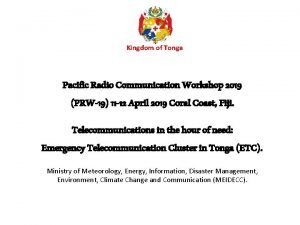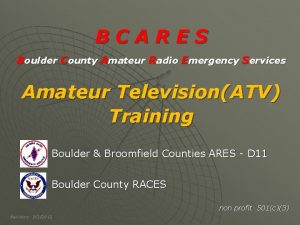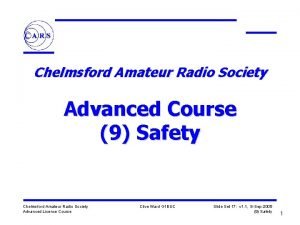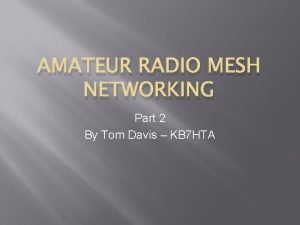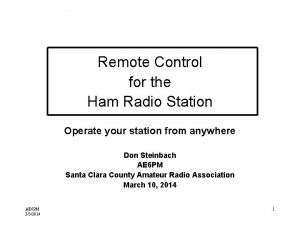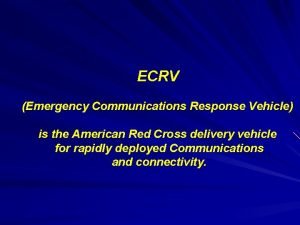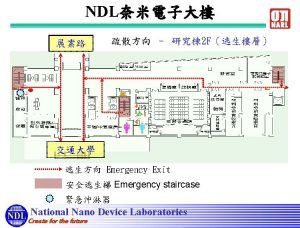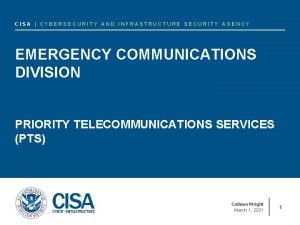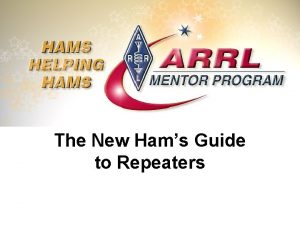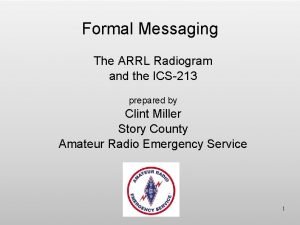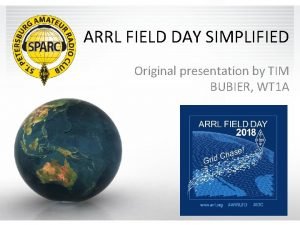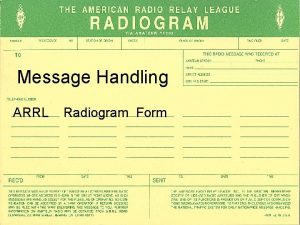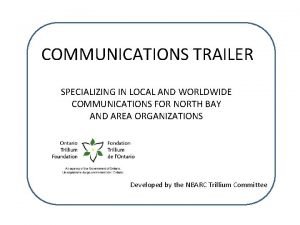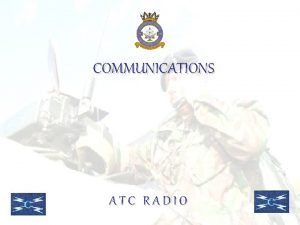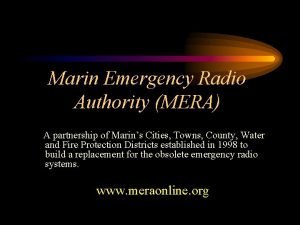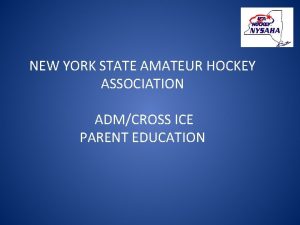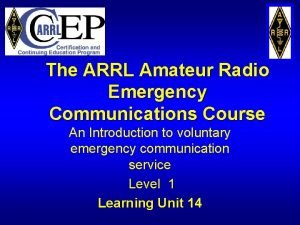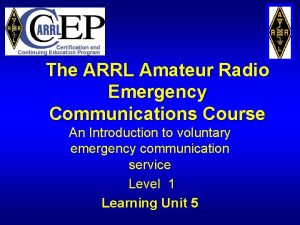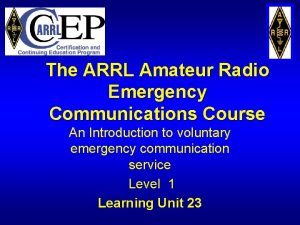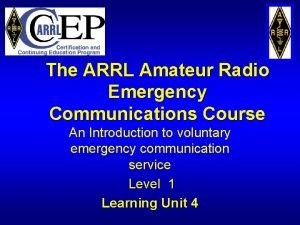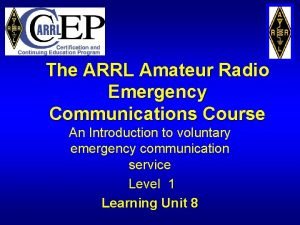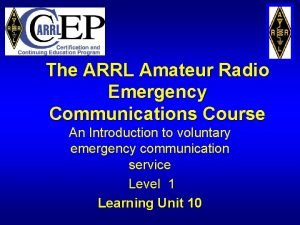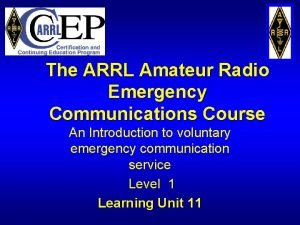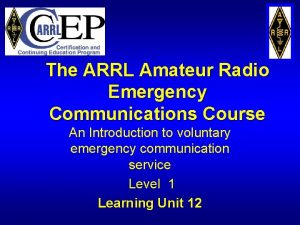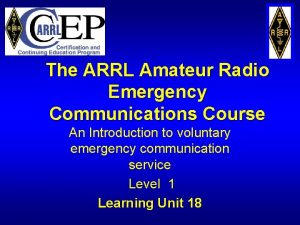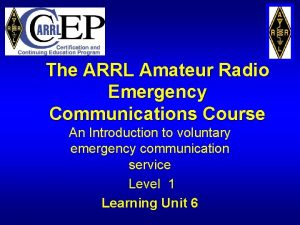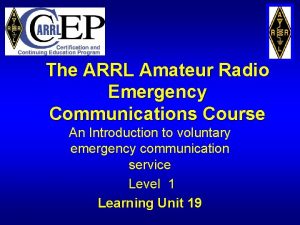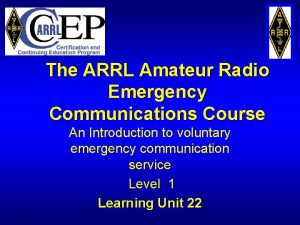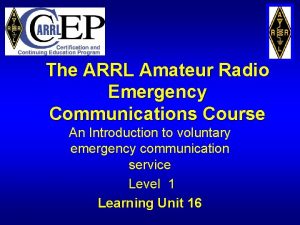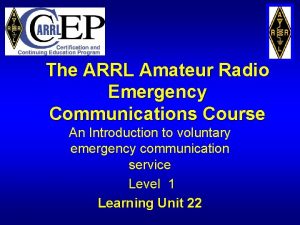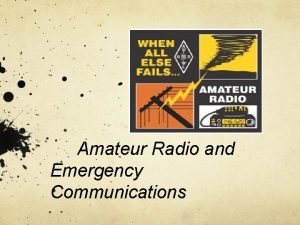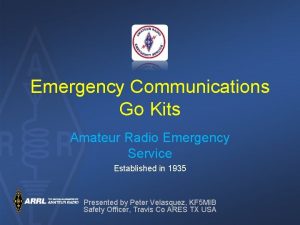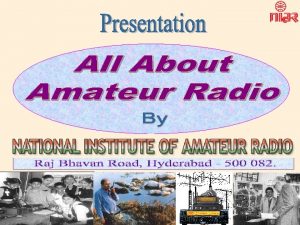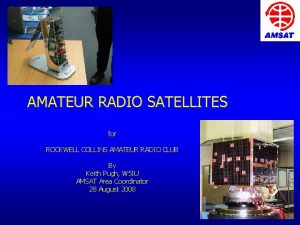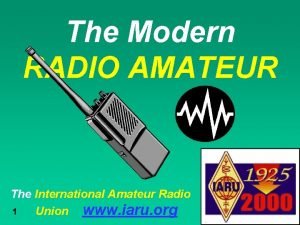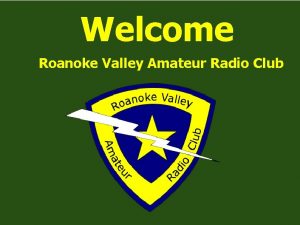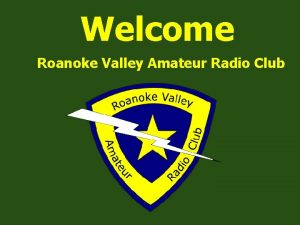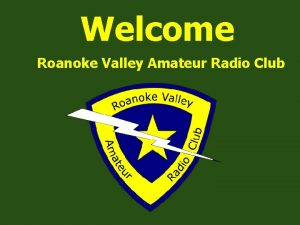The ARRL Amateur Radio Emergency Communications Course An



























- Slides: 27

The ARRL Amateur Radio Emergency Communications Course An Introduction to voluntary emergency communication service Level 1 Learning Unit 20

Hazardous Materials Awareness Learning Unit 20 Objectives: This learning unit introduces the reporting of hazardous materials (Haz. Mat) incidents and stresses personal safety awareness for emcomm volunteers.

Hazardous Materials Awareness Learning Unit 20 Student preparation required None

Information: Amateur radio operators may encounter Haz. Mat incidents during their travels, or they may be asked to assist with emergency communications in such incidents. Proper training is required for your own safety. Moreover, a wrong move by you during a Haz. Mat operation can endanger not only your own safety, but also the safety of other responders as well as the entire local community. The term "hazardous materials" (Haz. Mat) refers to any substances or materials, which if released in an uncontrolled manner (e. g. , spilled), can be harmful to people, animals, crops, water systems, or other elements of the environment. The list is long and includes explosives, gases, flammable and combustible liquids, flammable solids or substances, poisonous and infectious substances, radioactive materials, and corrosives. One of the major problems faced by emergency responders is determining which chemicals are involved and determining the potential hazards.

Hazardous Chemicals On The Move As the primary regulatory agency concerned with the safe transportation of such materials in interstate commerce, the US Department of Transportation (DOT) has established several systems to manage Haz. Mat materials. These include definitions of various classes of hazardous materials, placards and other marking requirements for vehicles, containers and packages to aid in rapid identification of cargoes, and an international cargo commodity numbering system. The DOT requires that all freight containers, trucks, and rail cars transporting these materials display placards identifying the hazard class or classes of the materials they are carrying. The placards are diamondshaped, 10 inches on a side, color-coded and show an icon or graphic symbol depicting the hazard class (flammable, caustic, acid, radioactive, etc). They are displayed on the ends and sides of transport vehicles. A fourdigit identification number may also be displayed on some placards or on an adjacent rectangular orange panel.

Hazardous Chemicals On The Move If you have spent any time on the roads, you have undoubtedly seen these placards or panels displayed on trucks and railroad tank cars. You may recognize some of the more common ones, such as 1993, which covers a multitude of chemicals including road tar, cosmetics, diesel fuel, and home heating oil. You may have also seen placards with the number "1203" (gasoline) on tankers filling the underground tanks at the local gas station.

Hazardous Chemicals On The Move

Hazardous Chemicals On The Move In addition to truck and rail car placards, warning labels must be displayed on most packages containing hazardous materials. The labels are smaller versions (4 inches on a side) of the same placards used on vehicles. In some cases, more than one label must be displayed, in which case the labels must be placed next to each other. In addition to labels for each DOT hazard class, other labels with specific warning messages may be required. Individual containers also have to be accompanied by shipping papers that contain the proper product name, the four-digit ID number and other important information about the hazards of the material.

Hazardous Chemicals in Buildings The National Fire Protection Association (NFPA) has devised a marking system to alert firefighters to the characteristics of hazardous materials stored in stationary tanks and facilities. This system, known as NFPA 704 M, can also assist citizens visiting a site in identifying the hazard presented by the stored substance. Use of the system is voluntary, unless specified by local codes. The NFPA 704 M label is diamond-shaped, and is divided into four parts, or quadrants. The left quadrant, colored blue, contains a numerical rating of the substance's health hazard. Ratings are made on a scale of 0 to 4, with a rating of 4 indicating a danger level so severe that a very short exposure could cause serious injury or death. A zero, or no code at all in this quarter, means that no unusual hazard would result from the exposure. The top quadrant of the NFPA symbol contains the substance's fire hazard rating.

Hazardous Chemicals in Buildings As you might expect, this quadrant is red. Again, number codes in this quadrant range from 0 to 4, with 4 representing the most serious hazard. The NFPA label's right quadrant, colored yellow, indicates the substance's likelihood to explode or react. As with the health and fire hazard quadrants, ratings from 0 to 4 are used to indicate the degree of danger. If a 4 appears in this section, the chemical is extremely unstable, and even under normal conditions may explode or react violently. A zero in this quadrant indicates the material is considered to be stable even in the event of a fire. The bottom quadrant is white, and contains information about any special hazards that may apply.

Hazardous Chemicals in Buildings There are three possible codes for the bottom quarter of the NFPA symbol: OXY means this material is an oxidizer. It can easily release oxygen to create or worsen a fire or explosion hazard. The symbol W indicates a material that reacts with water to release a gas that is either flammable or hazardous to health. If the material is radioactive, the usual tri-blade "propeller" symbol for radioactivity will appear.

Guidelines for Handling Haz. Mat Incidents 1. Once you are in a safe position up-hill and up-wind, try to identify the material. However, it cannot be over-emphasized that you MUST stay well away from the site. Do NOT be tempted to get just a little closer so that you can read placards or other items. If you cannot read these items using a spotting scope or binoculars, simply report what you can see from a safe position. If you are able to see from a safe position, look for: o The four-digit number on a placard or orange panel. o The four-digit number preceded by the initials "UN/NA" on a shipping paper, package or drum. o The name of the material on the shipping papers, placard, or package.

Guidelines for Handling Haz. Mat Incidents 2. Call for help immediately and let the experts handle the situation. Remember, even ordinary firefighters and police are prohibited by federal law from taking certain actions at some Haz. Mat incidents. Do not attempt to personally take any action beyond your report and preventing others from approaching. This is an instance when it is vitally important to know your limitations, not just for your own safety, but also for the safety of others.

Guidelines for Handling Haz. Mat Incidents 3. When reporting a Haz. Mat incident, include the following information: a. Identify yourself. b. Give your current location and the location of the incident, i. e. street address or cross streets, road and mile marker, distance from nearest town, etc. c. Briefly describe what you see (from a distance), i. e. liquid spill, gaseous cloud, etc, and any placard numbers or other information you can safely see. d. If a gaseous cloud or liquid spill exists, give the direction the contaminant is flowing or moving. Give any pertinent weather or other information you can observe from a safe distance that might help the experts in responding to the incident. Be concise.

Review If you happen upon a hazardous materials incident, first take precautions to protect yourself and others with you by remaining at a safe distance, upwind and uphill. Next, report any basic information you can safely gather, including placard legends and numbers, wind conditions, scene conditions, and other information to the appropriate public safety agency. Take no direct action except to report, and to protect yourself and others.

Student Activity Describe how you would handle the following situation: You are traveling through a rural area right behind a tornado, reporting damage and casualties to the local fire and police agencies as you go. Cresting a hill, you see a tank trailer overturned on the road ahead. No one else is around. A variable wind is blowing the leaking fumes in several directions unpredictably. You cannot see the placards on the truck from where you are.

Question 1 1. Which of the following BEST describes where you should be located when in the vicinity of a Haz. Mat incident? 2. A. B. C. Far away enough to ensure your safety. Downhill and downwind. Close enough to read the numbers on any placards with your naked eyes. D. Alongside emergency responders wearing exposure suits.

Answer 1 1. Which of the following BEST describes where you should be located when in the vicinity of a Haz. Mat incident? 2. A. Far away enough to ensure your safety.

Question 2 1. Which federal agency is responsible for warning the public about hazardous materials containers and shippers? 2. A. B. C. D. Federal Emergency Management Agency. Federal Response Plan. National Communications System. Department of Transportation.

Answer 2 1. Which federal agency is responsible for warning the public about hazardous materials containers and shippers? 2. D. Department of Transportation.

Question 3 1. Before transmitting in the area of a Haz. Mat incident what should you always do? 2. A. First identify the agents by reading the placard or container labels. B. Be far enough away so that no vapors or fumes are present. C. Wait to report the incident until police or fire officials have arrived. D. Take action to stop or contain any agents that might be leaking.

Answer 3 1. Before transmitting in the area of a Haz. Mat incident what should you always do? 2. B. Be far enough away so that no vapors or fumes are present.

Question 4 1. Which information will give responding authorities the most useful information? 2. A. B. C. D. Placard color Icon types Warning labels Four-digit numbers

Answer 4 1. Which information will give responding authorities the most useful information? 2. D. Four-digit numbers

Question 5 1. Gasoline tankers filling the neighborhood gas station's underground tanks are identified with a placard bearing which of the following? 2. A. B. C. D. 1203 1993 2003 2706

Answer 5 1. Gasoline tankers filling the neighborhood gas station's underground tanks are identified with a placard bearing which of the following? 2. A. 1203

 Amateur radio digital communications
Amateur radio digital communications Chelmsford amateur radio society
Chelmsford amateur radio society Ham radio tonga
Ham radio tonga Chelmsford amateur radio society
Chelmsford amateur radio society Bcares
Bcares Chelmsford amateur radio society
Chelmsford amateur radio society Ubiquiti link calculator download
Ubiquiti link calculator download Amateur radio mesh network
Amateur radio mesh network Remote control ham radio
Remote control ham radio Ecrv
Ecrv National emergency communications plan
National emergency communications plan Cisa emergency communications division
Cisa emergency communications division Travelplus for repeaters
Travelplus for repeaters Log book of the world
Log book of the world Arrl radiogram
Arrl radiogram Arrl grounding and bonding
Arrl grounding and bonding Winter field day exchange
Winter field day exchange Logbook of the world
Logbook of the world Arrl radiogram
Arrl radiogram Emergency communication trailer
Emergency communication trailer Atc communications and radio procedures
Atc communications and radio procedures Marin emergency radio authority
Marin emergency radio authority Trunking vs conventional radio system
Trunking vs conventional radio system Telescopio amateur
Telescopio amateur Random amateur
Random amateur Hot japanese amateur
Hot japanese amateur Amateur revenge
Amateur revenge New york state amateur hockey association
New york state amateur hockey association


